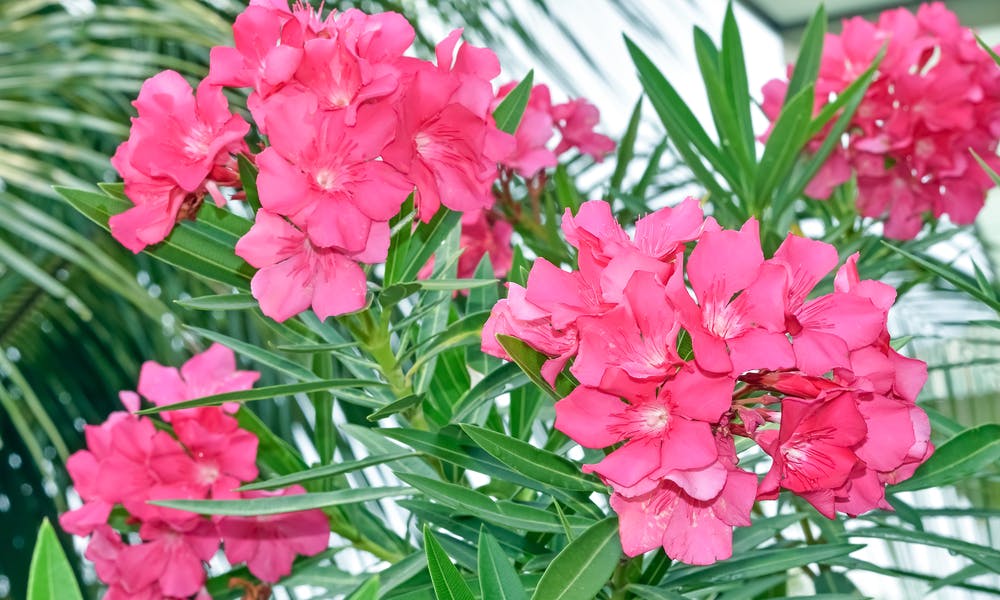MENU
Oleander Flower : The Toxic Beauty

The oleander (Nerium oleander) is an evergreen and ornamental shrub, with small, glossy leaves and pink-rose flowers. It has a delicate scent and is very easy to care for. However, ingesting the parts of the plant that contain glycosides can impact the heart muscles, so we must take great care in using it. Overdose can lead to serious intoxication. In the following sections, we introduce you to:
* Origin and description of an oleander flower
* How to grow and to care for oleander flower
* Uses of an oleander flower
* Toxicity, effects, and medical treatment
Origin and Description of Oleander Flower
Oleander plant, the only species classified until now of the genus Nerium, is a shrub of the family Apocynaceae. It is known as Nerium or oleander because of its resemblance to olea olives. Southwest Asia is said to be the region where it comes from, but its origin is not clearly identified. This plant perhaps comes also from Morocco or eastern Portugal, therefore from the Mediterranean region, and its origin can be extended to the southern parts of China.
Oleander is one of the most poisonous garden plants commonly grown. The oleander can grow from 6.5 to 19.7 feet in height, while its leaves are in pairs, colored in dark green. The flowers are in the form of clusters and are beautifully colored. They can be purple, red, pink or yellow, and often they have inflorescences with double flowers. They have a corolla of five lobes and emit a sweet scent. The fruit is a capsule that contains many seeds. More than 400 species of oleander are known all over the world.
Oleander flowers are spectacular, and they are widely used as ornamental plants, especially in countries with a warm climate. In California, you often find them dividing lanes on highways.
How to Grow and Care for Oleander Flower
The oleander is not pretentious; it blooms from spring, throughout summer to autumn. The plant does not like excess moisture and is not resistant to very low temperatures. When the winters are very cold, the plants should be put into pots and placed indoors.
Oleanders, perennial plants, can handle drought or nutrient-poor soil conditions. Although it contains toxic substances, the oleander shrub is cultivated for its beauty and you can get a spectacular blooming if you expose it in full sun, but it can also be cultivated in partially shaded areas.
Planting the oleander is not difficult. Although they like a neutral soil pH, these plants can adapt to any kind of soil. If your soil is excessively poor, you should add a few organic substances such as compost, to improve the absorption of water. You should regularly water your plant after planting until the roots have developed properly.
After its flowering in spring, it is ideal to cut off the superfluous branches in order to maintain an optimum size for your plant and a beautiful crown. For growing an oleander shrub in a pot, you should choose a suitable recepticle that has to be always higher than wide, at a rate of two to one, ensuring that all roots grow down. You should place two inches of gravel at the bottom of the pot. Then, fill with a mixture of leaf soil, two parts compost and manure, two parts flower soil, and one-part coarse grain sand.
The oleander is a plant that loves light and strong heat. As a result, the ideal location near your home would be near a south or southwest wall, where the plant is protected from wind or rain. During the night, the heated wall could provide the much-needed warmth to your plant.
Uses of Oleander Flower
In India, oleander is used in traditional medicine in the treatment of leprosy, dermal, and ocular disorders. The leaves are also used as antidotes to snake bites. It is often prepared as a green leaf infusion or maceration along with tomato seeds and white onion as an antirheumatic remedy.
Because of its toxic potential, today the oleander is not so popular anymore. The leaves are known for their cardiotonic impact and have a pronounced diuretic effect. Furthermore, they were also discovered as possessing sedative and antibacterial properties against gram-positive and gram-negative microorganisms (in vitro studies).
Toxicity, Effects, and Medical Treatment
Oleander flower contains many known toxins, such as cardiac glycosides as oleandrin and nerine, and also toxins as saponins and nerioside. These are found in all parts of the plant and are toxic even if the plant is dry. One single leaf ingested by a baby or small child can cause death. The toxins are very concentrated in sap, which, if it comes in contact with human skin, can cause numbness and very severe irritation.
The symptoms of poisoning with oleander are skin rashes, vision disorders, transit disorders, vomiting, irregular heartbeat, dizziness, fainting, decreased pulse, and depression. The oleander is also dangerous for ruminant animals: cattle, sheep, and horses, among others. For example, 100 grams of oleander can kill an adult horse. The manifestation of the effect of ingesting the plant in a horse is abnormal heartbeat and diarrhea.
In case of intoxication with oleander, you have to urgently request medical assistance. The most common remedies for oleander poisoning are stomach washes, charcoal administration and, if vomiting induction has no effect, medication is administered.
The rate of poisoning with oleander is quite low in the world, but it also brings some great news for future patients. In this respect, we should not neglect that there is ongoing research regarding the possibility of discovering the cure for cancer using oleander extracts.
All in all, oleander is a charming, fragrant shrub, but, at the same time, very dangerous due to the toxic substances it contains. Be careful where you place it so that your children or your pets and animals do not have access to it.

